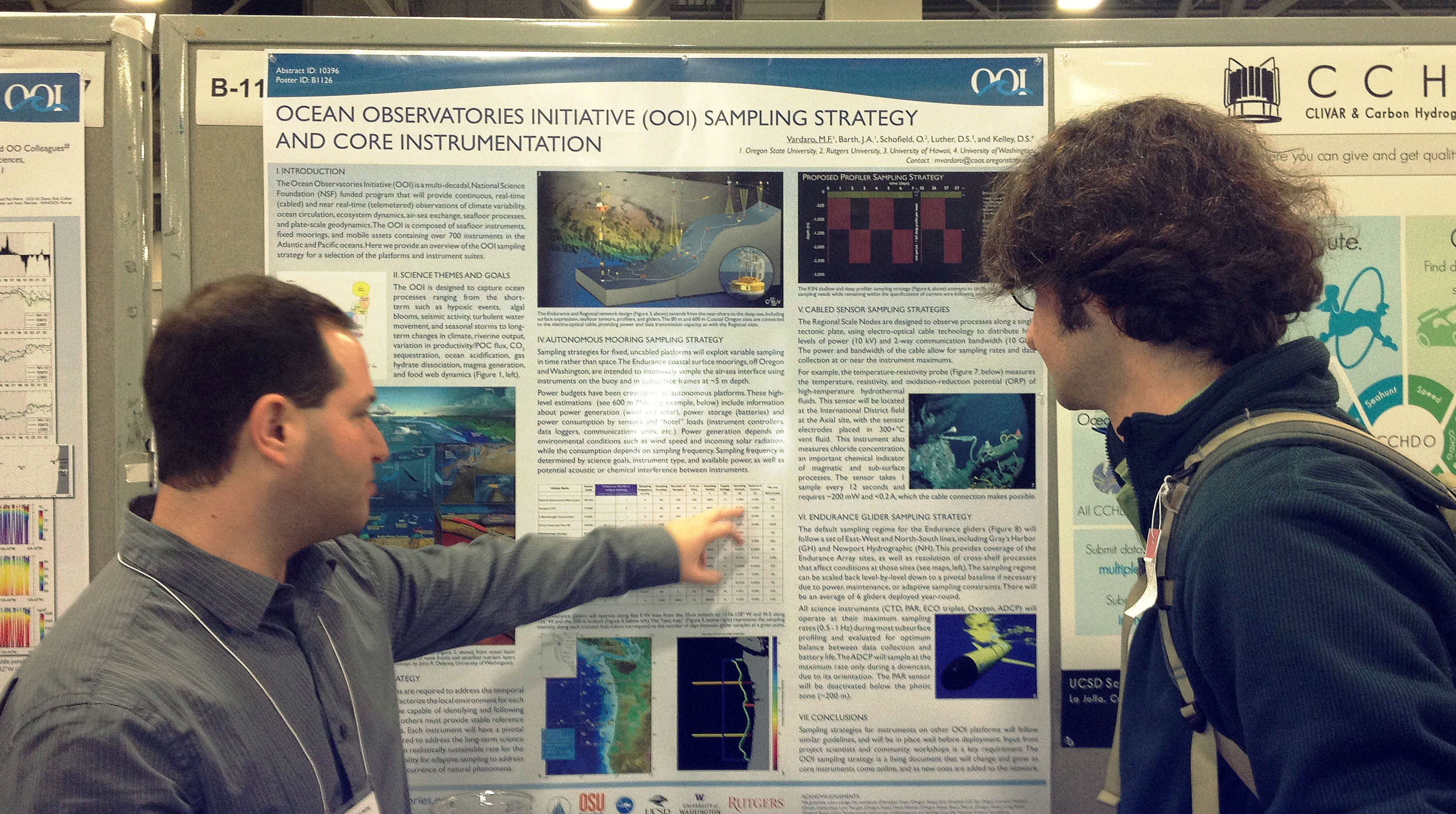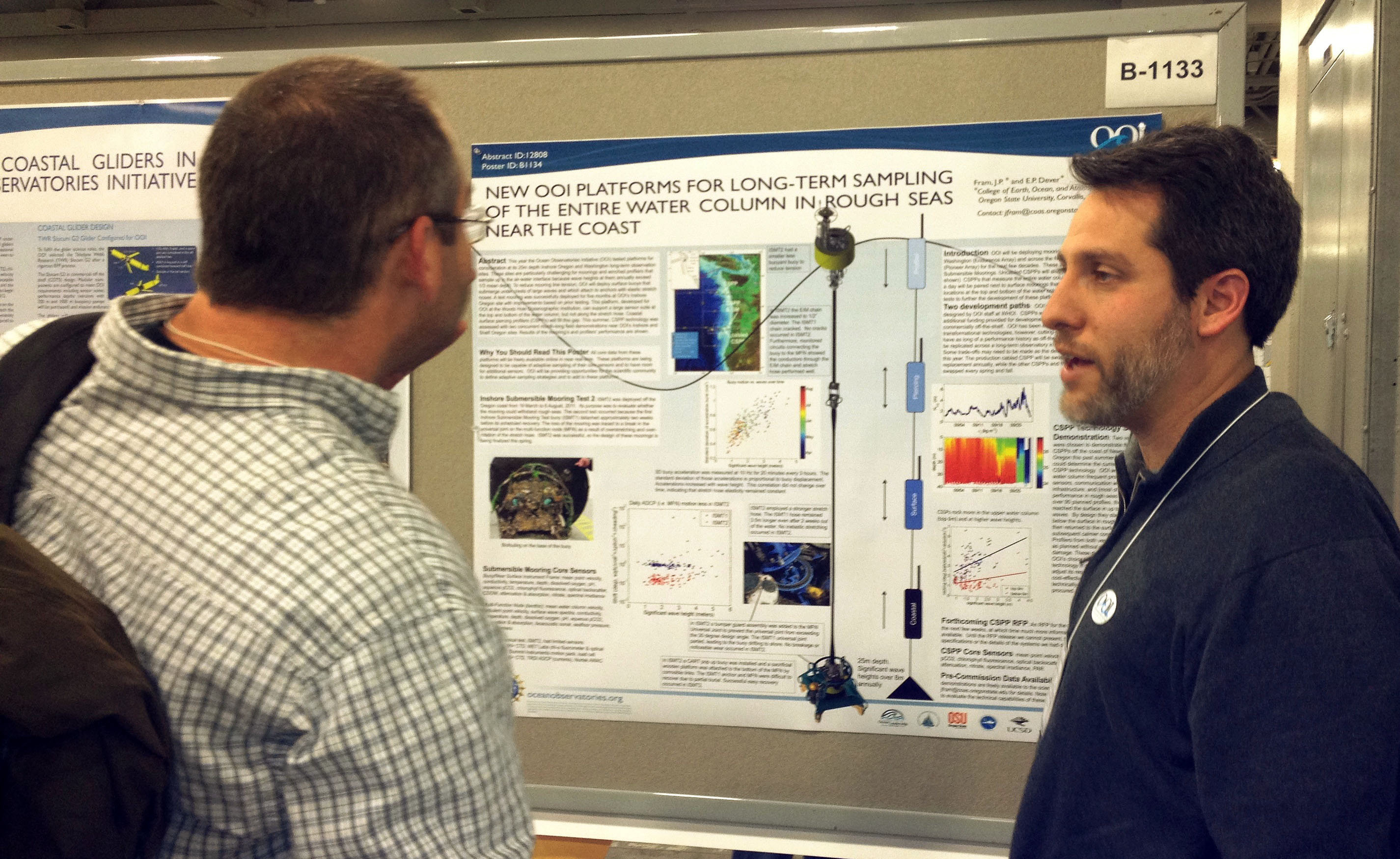Ocean Observatories Initiative Team Returns from a Successful 2012 Ocean Sciences Meeting

(Click to enlarge) Dr. Michael Vardaro, OOI Associate Project Scientist from Oregon State University, explains his poster at the 2012 Ocean Sciences Meeting in Salt Lake City, Utah. (Photo Credit Megan Gibney)
The Ocean Observatories Initiative (OOI) is back from a successful 2012 Ocean Sciences Meeting in Salt Lake City, Utah. During the conference, OOI team members held a variety of sessions, posters and information sharing opportunities. At the OOI booth, team members fielded questions from a variety of enthusiastic visitors and provided demonstrations of the online OOI Instrument Tables.
On Tuesday morning of the conference, OOI Senior Project Scientist Steve Ackleson gave a talk on the history and future directions of ocean observatories. This was part of a session he co-chaired in collaboration with Ocean Networks Canada, University of Maine, and NEPTUNE Canada on the integrative power of ocean observatories. You can download a PDF of his talk HERE
In addition to scheduled scientific sessions, the OOI Team held a series of special informational sessions over three days to provide interested attendees with an update on recent OOI activities and opportunities for community involvement. You can download a PDF of that presentation HERE

(Click to enlarge) Dr. Jonathan Fram, OOI Associate Systems Engineer from Oregon State University, describes new OOI platforms at the 2012 Ocean Sciences Meeting in Salt Lake City, Utah. (Photo Credit Megan Gibney)
If you missed the meeting and would like to learn more about what is happening in the program, check out the poster links below.
- COMPARING AUTOMATIC VERSUS HUMAN-CREATED QUALITY CONTROL FLAGS OF OCEANOGRAPHIC MOORING DATA AND APPLICABILITY TO THE OOI
- BUILDING A HIGH-POWER AND HIGH-BANDWIDTH CABLED OBSERVATORY ON AN ACTIVE VOLCANO: AXIAL SEAMOUNT
Poster Summaries
SCIENCE AND DATA PRODUCTS FROM THE OCEAN OBSERVATORIES INITIATIVE
Authors: Lorraine Heilman, Susan Banahan, Sarah Webster, Jon Fram, Mike Vardaro, Giora Proskurowski, William Bergen, Steve Ackleson
Summary: This poster describes OOI data, products, algorithms, levels of processing, quality control, intermediate products, sampling frequencies, data volumes and data rates. Several specific examples of data processing are described along with the description of all planned data products. It introduces the scientific community to the specific products that will be available in this unprecedented opportunity for oceanographic, benthic and air-sea research.
COMPARING AUTOMATIC VERSUS HUMAN-CREATED QUALITY CONTROL FLAGS OF OCEANOGRAPHIC MOORING DATA AND APPLICABILITY TO THE OOI
Authors: Matthias Lankhorst, Hey-Jin Kim
Summary: A suite of computationally simple algorithms for data quality control (QC) is presented that generates pass/fail flags for oceanographic data from moorings. This poster addresses the development and tuning of these algorithms as part of the OOI.
OOI SAMPLING STRATEGY AND CORE INSTRUMENTATION
Authors: Mike Vardaro, Jack Barth, Oscar Schofield, Doug Luther, and Deborah Kelley
Summary: This poster addresses the OOI sampling strategy that must consider event-driven sampling responses, mitigation of between-sensor interference, data products that require multiple sensors, the need for physical sampling to validate and calibrate OOI sensors, and the eventual incorporation of non-core sensors into the network.
NEW OOI PLATFORMS FOR LONG TERM SAMPLING OF THE ENTIRE WATER COLUMN IN ROUGH SEAS NEAR THE COAST
Authors: Jon Fram, Edward Dever
Summary: This year the Ocean Observatories Initiative (OOI) tested platforms for consideration at its 25m depth Oregon and Washington long-term observation sites. This poster addresses assessments of recent tests and plans for platforms for long-term sampling. Results of the mechanical performance of mooring and profilers are shown along with an illustration from these data of the scientific value these paired platforms will provide.
THE ROLES OF COASTAL GLIDERS IN THE OOI
Authors: Edward Dever, Jack Barth, Al Plueddemann, Oscar Schofield; Uwe Send
Summary: The OOI plans to begin operational deployment of gliders on the coastal scale OOI arrays in May 2012. This poster describes the roles of coastal gliders in OOI, reporting on the testing progress and updating the plans for operational deployments in the coastal scale arrays of OOI.
BUILDING A HIGH-POWER AND HIGH-BANDWIDTH CABLED OBSERVATORY ON AN ACTIVE VOLCANO: AXIAL SEAMOUNT
Authors: Deborah Kelley, John Delaney and OOI RSN Team
Summary: Axial Seamount is the most active volcano on the Juan de Fuca Ridge, erupting in 1998 and 2011. It is both seismically and hydrothermally active, and hosts diverse biological communities. It is a long-term NOAA-PMEL observatory where long-term co-registered fluid chemistry-temperature-microbiological measurements have been made that begin to quantify the microbial evolution at the decade scale of seafloor eruption cycles. Because of these characteristics, Axial was chosen as the US’s first cabled observatory at a submarine volcano. This 5-year construction and 25-year operational project is part of the NSF’s Ocean Observatories Initiative. This poster addresses the Axial Seamount area and the OOI RSN teams work there.
ANNOUNCEMENT OF THE CORE INSTRUMENT MODELS AND LOCATIONS
Authors: Merrie Beth Neely, Anthony Ferlaino, Barry Stamey
Summary: The OOI has selected the vendors and models for many of the 49 Core Instrument Families that will be located on the arrays. The sensor models and their location-specific features are presented here, with reference to their generalized data product available from OOI’s Integrated Observatory Network data portal. Approximately 750 instruments are expected to complement the OOI arrays at the time of commissioning. This poster provides information on core instruments and locations.
OBSERVATIONS OF ANOMALOUS NEAR-SURFACE, LOW-SALINITY PULSES OFF THE CENTRAL OREGON COAST
Authors: Craig Risien, Piero Mazzini, Jack Barth
Summary: The Columbia River plume is a dominant feature of the Pacific Northwest coastal hydrography. This poster presents the spatial/temporal evolution of low-salinity pulses during June and July 2011. Analysis of in situ data off of Newport collected from OSU autonomous underwater gliders, Ocean Observatories Initiative (NSF funded) and the Northwest Association of Networked Ocean Observing Systems (NANOOS; NOAA funded) moorings, as well as remotely sensed data, show that the on-offshore location of the plume front is not controlled by riverine discharge rates, but rather by Ekman dynamics, and that these freshwater pulses reach the coast.
THE FUTURE OF REAL-TIME MONITORING OF METHANE HYDRATE DEPOSITS AT ACTIVE CONTINENTAL MARGINS: THE OOI CABLED OBSERVATORY AT HYDRATE RIDGE
Authors: Orest Kawka, Deborah S. Kelley, John R. Delaney, Evan Solomon, OOI-RSN Team
Summary: Hydrate Ridge is characterized by an extensive system of subsurface gas hydrate deposits, active plumes, and extensive biological communities. Previous studies of its subsurface geology and these seep-supported benthic communities highlighted the need for an integrated, synoptic, and long-term approach to the study of carbon cycling in such continental margins. In 2013, the cabled observatory component of the OOI, known as the Regional Scale Nodes (RSN), will begin deploying an array of seafloor instruments at Southern Hydrate Ridge. The poster discusses RSN’s built-in expandability and 25-year lifetime will provide unprecedented opportunities for long-term high-resolution studies, furthering our understanding of gas hydrates and carbon cycling in such systems and potential global effects associated with tectonic activity and climate change.
OCEAN OBSERVATORIES INITIATIVE: CONSTRUCTION PROGRESS UPDATE
Authors: Tim Cowles and Susan Banahan
Summary: The National Science Foundation’s (NSF) Ocean Observatories Initiative (OOI) is implementing the construction and operation of an interactive, integrated ocean observing network. This presentation will provide information on major advances in OOI construction and an update on overall program plans.
